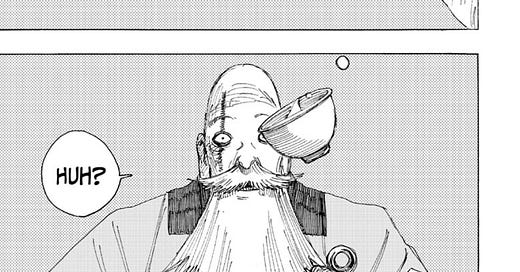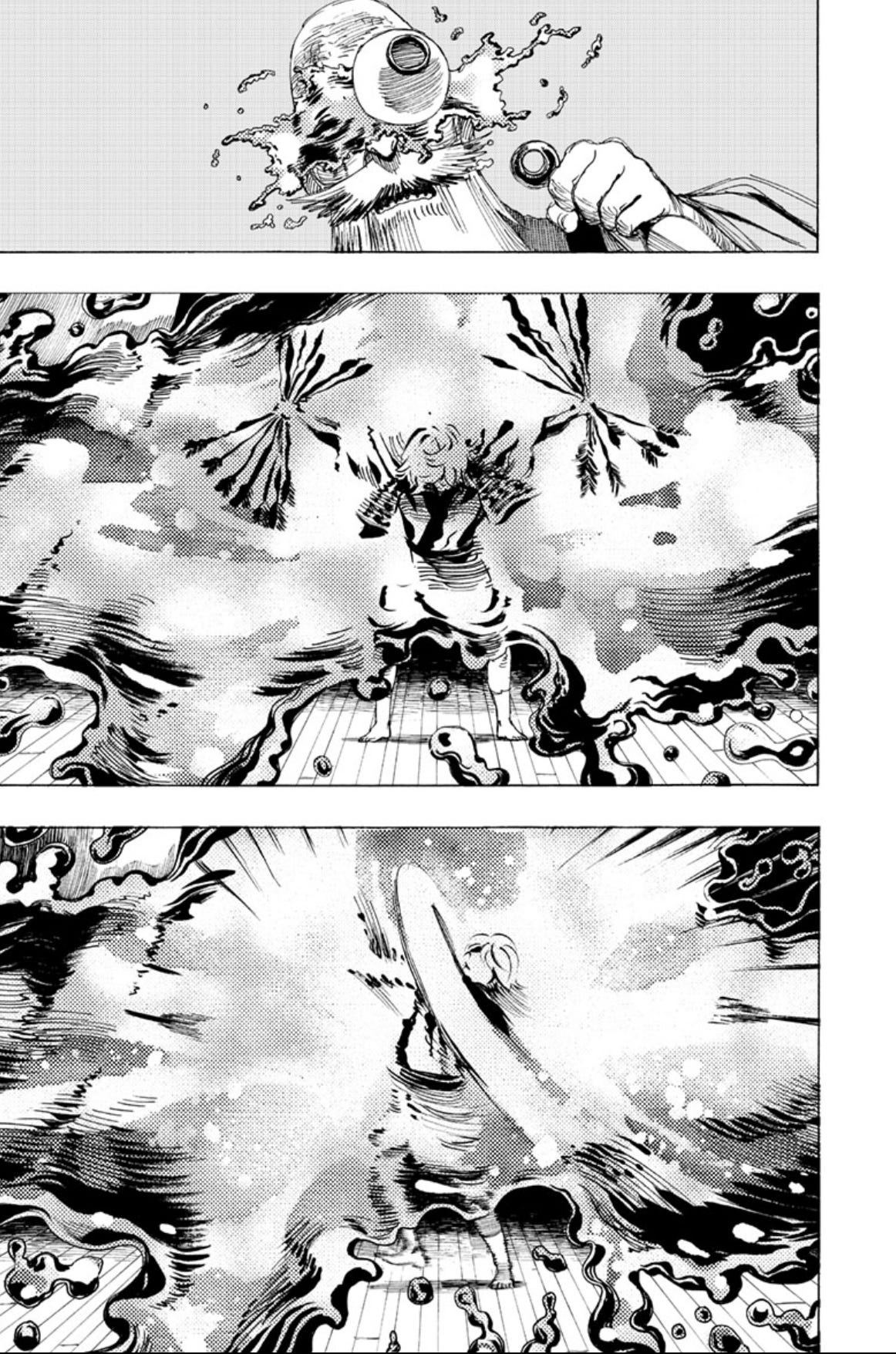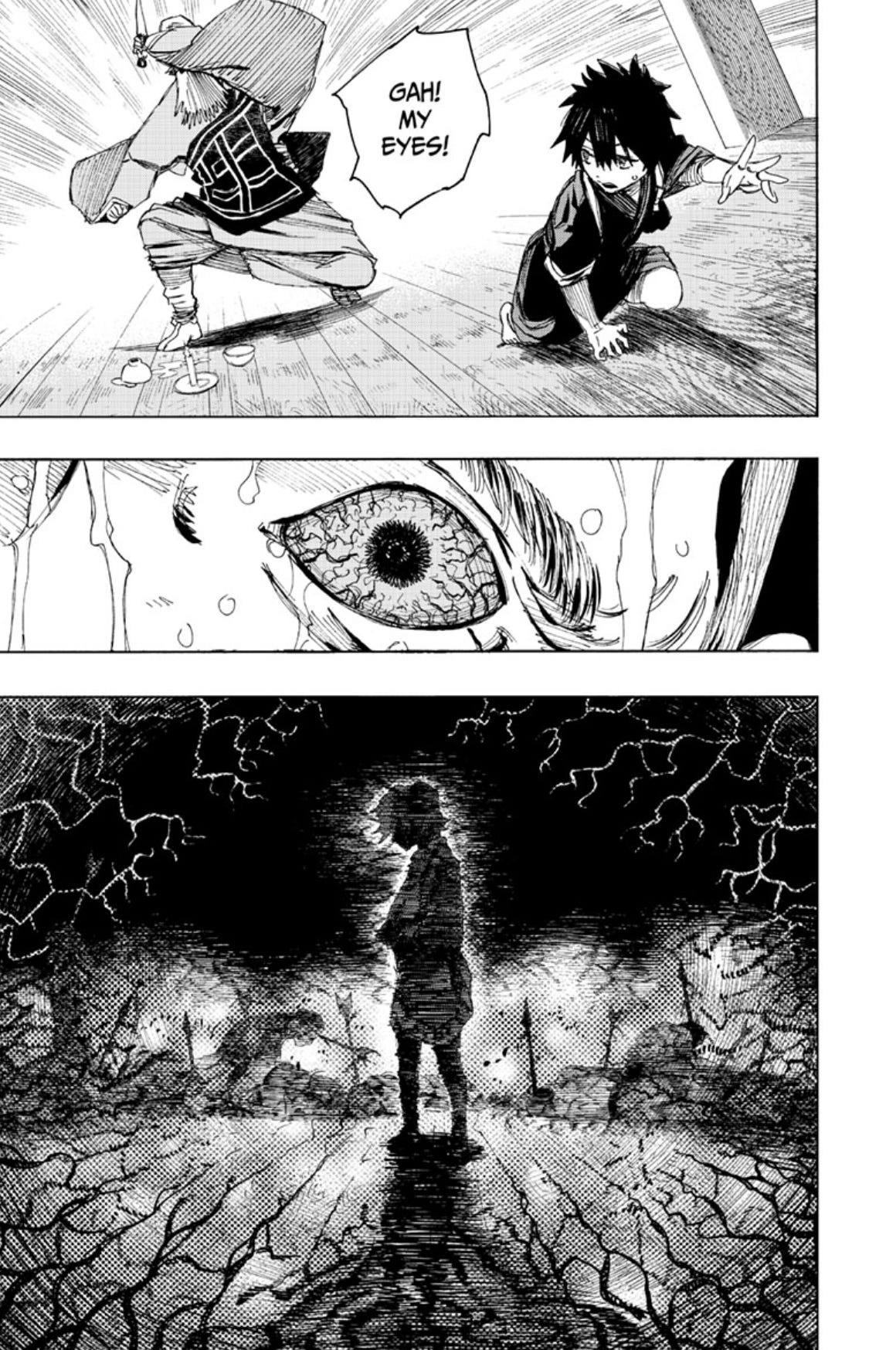Hell's Paradise: The Tea Scene Masterclass
One scene to rule them all, and all staged around a cup of tea.
Alright friends, we’re going to do something a bit differently today. Honestly, I’ve had trouble getting deep into series lately, so I’m unearthing an idea I wanted to start ages ago, but never got around to.
I’ve zoomed in on singular great panels, but there are scenes that do the same. Scenes that, in isolation, are just breathtaking, and I don’t use that word lightly. Naturally, one such scene exists thanks to my favorite mangaka, Yuji Kaku and his masterclass, Hell’s Paradise. In case you missed my previous assertions, this is the only series I’ve ever called perfect.
And this isn’t even from the main series, it’s from the one shot side-story, Forest of Misfortune.
Let me set the scene. Our immortal assassin, Gabimaru, is looking to plant himself a farm near this small village, but the kids in the village keep trying to kill him. Gabimaru makes a deal with them—for each time they try to kill him, they have to teach him something about farming. Cute, right? It’s a really fun set-up.
But, turns out, all the adults in this small town are sick and dying, that’s why all the kids are acting on their own. They’re being taken care of by a monk. This monk finally meets Gabimaru while the leader of the kids sleeps. But Gabimaru already sees what’s happening. This monk is the problem. He’s the leader of some bandits, and the tea he gave Gabimaru is poisoned. Naturally, the toxin doesn’t affect Gabimaru, and that’s where this scene begins.
Now let’s go page by page.
Gabimaru drops his cup of tea to feign that the toxin is working, but in the first panel, he kicks it at the monk, who just now realized that he doesn’t actually know what’s going on. And all the archers surrounding Gabimaru from above are given the command to fire. Spoiler: bad idea.
The archers fire, all the arrows are honing in on Gabimaru, but our favorite assassin is untroubled, as he often is. Notice that his foot is still extended, as the kicking motion isn’t even completed yet.
Now this is when things get really good, because Yuji Kaku starts incorporating different perspectives in the panels. To start the page, we get the context we need—the tea has begun hitting the monk in the face. The subsequent panels—gorgeous panels, it must be said—are from the monk’s point of view. The tea is obscuring his vision. Notice that the teacup still hasn’t reached him, though.
Gabimaru finally looks up. He’s ready to act.
In that moment, Gabimaru’s freakish reflexes kick in and he starts catching the arrows that were supposed to kill him. Notice his eyes, how he can perceive every angle, from every direction.
This is where we fully grasp just how quickly all of this is happening. How this entire scene, essentially, is taking place in a mere moment, maybe two. The teacup has only just clattered into the monk’s face, fully obscuring his view with liquid, but even in the obscured view, we see Gabimaru in action, catching all the arrows and tossing them back from whence they came.
This is a two-page spread, the monk’s eyes still obscured by tea, but Gabimaru has completed the action of tossing all the arrows back from whence they came, meaning…
All the archer’s have been force-fed the arrows they shot at Gabimaru (those idiots), and the tea cup clatters to the ground. I love the tea cup clattering to the ground, because it’s a completion of the singular moment that began with Gabimaru kicking it towards the monk. Think about it, in the time that the teacup traveled that short distance and hit the ground, Gabimaru seamlessly impaled every archer with their own arrow.
The toxin has started to affect the monk’s eyes as the little girl begins scampering away. And then—my favorite panel of them all. Through the monk’s toxin-filled eyes, he sees Gabimaru standing, a shadow among death, and totally unbothered. It’s a gorgeous panel.
And the culmination of it all, which is masterfully blocked. Gabimaru is still in the exact same pose (seriously, stack his outlines on top of each other) as my favorite panel from the previous page, but this time we get the full context of the situation. The archer’s lay dead all around Gabimaru and, this time, the monk—even though he’s still armed—is recoiling in fear.
And! Please notice the circle of light around Gabimaru’s head. My dude’s an angel!
I need to catch my breath every time I take in this scene. If you think about it, it could have been captured in a page or two, but by expanding these seconds, we can lean into the gorgeous artistry.
There are so many things to adore about it, but I want to take them point by point.
You never lose context, despite the artistic chances taken
I rarely see first-person perspective used in manga. Or in any medium, for that matter, and often when it is used in movies, it feels a little… wobbly. But here, five panels and a two page spread are in first-person, and all of them partially obscured by tea or toxin.
That lends itself to a potential snag—will we, as readers, be able to follow the sequence of action and understand what we’re seeing?
And the answer is a hearty YES. Because Yuji Kaku takes time to establish, on pages that progress into first-person perspective, what is causing this particular obstruction of sight. First, it’s the splash of tea hitting the monk, then its the teacup itself hitting him, leaving behind the rest of its contents, and lastly, it’s the toxins setting into his eyes.
With these contextual checkpoints, we can understand what we’re seeing, just in case there was any doubt.
Time is tracked in clever ways
Everything has to track, and just like how Yuji Kaku keeps contextual checkpoints to ensure we know what’s actually happening, he has time tickers, if you will, so we can see how little time is passing.
The first and most obvious time ticker is the teacup. Go ahead, kick a cup of tea, see how long it takes to travel five feet. By showing the flight of the teacup from the moment it leaves Gabimaru’s foot to the moment it clatters to the ground, we keep track of time as all the action happens. That’s not a lot of time, because—spoiler—it doesn’t take long for a tea cup to go that far, even if that teacup takes a pitstop to spill in a crooked monk’s face. By extension, the spill of tea is also a time ticker. Tea is—spoiler—a liquid, and that means it—spoiler—runs down inclines, including but not limited to faces.
The arrows are another time ticker. Arrows are—spoiler—fast. (Okay, I’ll stop now.) If they are shot, even from a balcony, it’s maybe a second, if that, before they hit their target. Add another second for Gabimaru to catch them and fire them back in a singular motion.
But what about when the tea cup, the tea, and the arrows are all at their final destinations? The final ticker is the girl, scampering away from the monk. We see her when the monk whimpers about his eyes, rising to run, and we see her again in the final moment of centering, making her first step. Again, not a lot of time. Speaking of…
So little time passes
How much time actually passes here? I’d say maybe five seconds. That’s difficult to convey with so much happening. So many little things could cast doubt on what could be achieved in that small period of time. This is what’s really so special about this scene. While time is tracked by all these incredible methods, the reason that’s so important is to emphasize how little time is passing.
This scene is mere seconds, yet here’s a progression of what happens:
Gabimaru kicks a teacup towards the monk
The archers fire
Gabimaru stands up
Gabimaru catches all the arrows with his bare hands
The teacup hits the monk in the face
Gabimaru flings the arrows back where they came from
The teacup hits the ground (alive)
The archer’s hit the ground (dead)
The girl gets away
It’s a lot. But, despite Gabimaru’s obscene skill level, which I’ll get to in a second, it makes sense that all of this could be accomplished in such a short time frame because it’s really only two actions—the tea cup and the archers, both of which are very fast actions.
Gabimaru is, as always, unstoppable.
In case I haven’t made this abundantly clear, Gabimaru is far and away my favorite protagonist ever. Which is interesting because I generally don’t like over-powered protagonists, but he has always wielded his OP-ness like a curse. All he wants in life is to be with his wife. The fact that he can’t die and can kill literally anyone or anything, that’s just part of life, facilitating him getting home to his wife safe and sound.
Still, in this scene, there are three things that Gabimaru does that accentuate how skilled he is.
A teacup is a weapon
Arrows are playthings
The girl is safe
And through it all, Gabimaru makes, really, just four motions.
Kicks the teacup
Catches the arrows
Stands up
Throws the arrows
In just four motions, he defeats a small army, frees a hostage and corners the bad boss. Three cheers for Gabimaru, am I right?
No really though, for every cheer you give Gabimaru, give three for Yuji Kaku. So… nine cheers for Yuji Kaku.













Loved the deep dive into this scene — as short as it would have been in real time hahaha
You know how much I love tea, I’m drinking some now. BUT I love this Manga Craft even more!! One heck of a tea scene indeed!!